Dorian Yates, a six-time Mr. Olympia winner, revolutionized bodybuilding with his Blood and Guts Workout, a high-intensity training method emphasizing progressive overload and mental toughness for serious lifters seeking significant muscle growth and strength gains.
1.1 Who is Dorian Yates?
Dorian Yates, known as “The Shadow,” is a legendary six-time Mr. Olympia winner (1992–1997). Born in England in 1962, he rose to fame with his intense training style and dominant stage presence. Yates’ no-nonsense approach and groundbreaking “Blood and Guts” philosophy transformed bodybuilding, emphasizing high-intensity workouts and mental toughness. His journey began in local gyms, overcoming early challenges to become a global icon. After retiring, Yates remained influential, opening gyms and advocating for mental health awareness, solidifying his legacy as one of bodybuilding’s greatest champions.
1.2 The Concept of the Blood and Guts Workout
The Blood and Guts Workout, developed by Dorian Yates, is a high-intensity training program focused on progressive overload and mental toughness. It emphasizes working to failure, minimal rest periods, and a mind-muscle connection to maximize muscle growth; The program is designed for serious lifters seeking significant strength and size gains through efficient, targeted workouts. By pushing the body to its limits, the Blood and Guts method fosters resilience and dedication, making it a cornerstone of modern bodybuilding for those willing to embrace its intense demands.
1.3 Why the Blood and Guts Workout is Popular
The Blood and Guts Workout’s popularity stems from its effectiveness, simplicity, and focus on mental toughness. It appeals to serious lifters seeking significant muscle growth and strength gains through high-intensity training. The program’s emphasis on progressive overload and muscle engagement resonates with those who value efficiency and results. Additionally, its straightforward structure and adaptability to individual goals make it accessible to both experienced athletes and newcomers. The workout’s reputation for delivering real transformations, combined with Dorian Yates’ legendary status, has solidified its place as a cornerstone in modern bodybuilding culture.
The Origins of the Blood and Guts Program
Dorian Yates developed the Blood and Guts Workout, drawing from his successful bodybuilding career. The program emphasizes high-intensity training to maximize muscle growth and strength for dedicated lifters.
2.1 Dorian Yates’ Background in Bodybuilding
Dorian Yates’ journey in bodybuilding began in his late teens, inspired by the gym culture in Birmingham. He quickly rose through local competitions, winning the 1983 Novice British Championships. His intense work ethic and genetic predisposition for muscle growth set him apart. By the early 1990s, Yates became a dominant force, claiming his first Mr. Olympia title in 1992. Over the next six years, he secured six consecutive Mr. Olympia victories, solidifying his legacy. His retirement in 1997 due to injuries didn’t diminish his impact, as he remains a revered figure in the sport.
2.2 The Development of the Blood and Guts Philosophy
The Blood and Guts Philosophy, developed by Dorian Yates, emphasizes high-intensity training and mental fortitude. It was crafted through his competitive bodybuilding career, focusing on pushing limits and maximizing muscle engagement. This approach differs from traditional methods by prioritizing intensity over volume, ensuring each workout is purposeful and challenging. Yates’ philosophy centers on progressive overload and a strong mind-muscle connection, creating a disciplined and effective training system that has inspired many to adopt his rigorous approach.
2.3 Key Influences on the Workout Routine
Dorian Yates’ Blood and Guts Workout was influenced by several key factors. Firstly, the training philosophies of bodybuilding legends such as Arnold Schwarzenegger and Ronnie Coleman played a significant role. Additionally, Yates’ personal experiences and successes in competitive bodybuilding shaped his approach. The era in which he trained, the late 80s and early 90s, also brought about specific training trends that impacted his routine. Furthermore, his own experiments and innovations in high-intensity training contributed to the development of the Blood and Guts method, making it unique and effective.
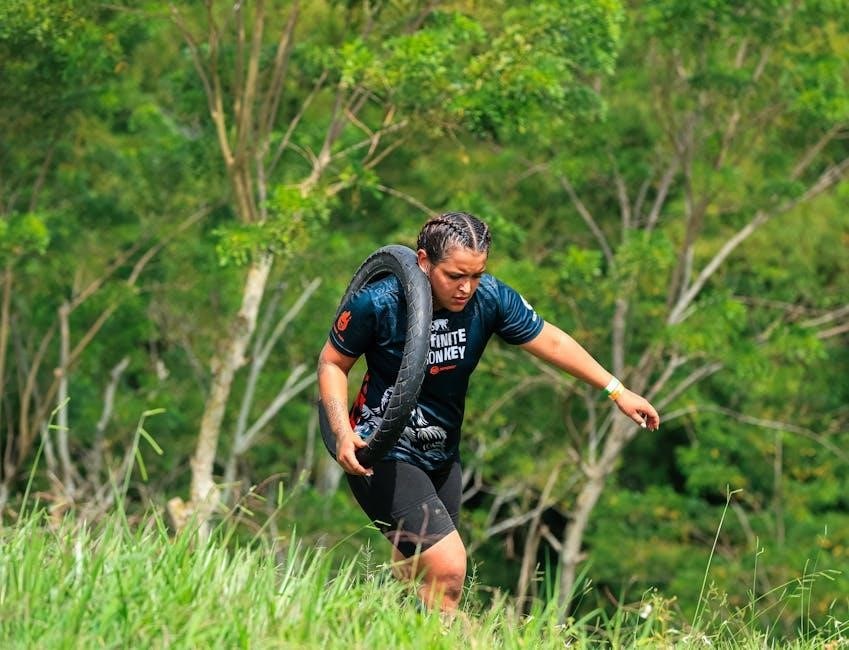
The Core Principles of the Blood and Guts Workout
The Blood and Guts Workout revolves around high-intensity training, progressive overload, and a strong mind-muscle connection. It emphasizes rest and recovery to maximize muscle growth and strength effectively.
3.1 High-Intensity Training (HIT)
High-Intensity Training (HIT) is the cornerstone of Dorian Yates’ Blood and Guts Workout. This approach focuses on pushing muscles to absolute failure within a limited number of sets, typically 1-3, using heavy weights. HIT emphasizes quality over quantity, ensuring maximum stimulation for growth. By minimizing rest periods and maximizing effort, HIT forces the body to adapt rapidly. Yates believed that this method optimizes muscle fiber recruitment and metabolic stress, leading to faster gains. The mental and physical demands of HIT create a transformative training experience, separating it from conventional routines.
3.2 Progressive Overload
Progressive overload is a cornerstone of the Blood and Guts Workout, emphasizing the gradual increase in weight, reps, or sets to challenge muscles continuously. This principle ensures consistent strength gains and muscle growth by pushing the body beyond its current capacity. Yates advocates for incremental increases, allowing for adaptation while avoiding plateaus. Proper form is maintained to maximize effectiveness and prevent injury. Over time, this systematic approach builds formidable strength and muscle mass, making it a key driver of success in the Blood and Guts program.
3.3 Mind-Muscle Connection
The mind-muscle connection is a cornerstone of the Blood and Guts Workout, emphasizing mental focus to engage the target muscle during exercises. Dorian Yates stressed the importance of concentration to maximize muscle activation, ensuring efficient growth and strength gains. This approach minimizes unnecessary strain on secondary muscles, promoting precise and effective training. By maintaining a strong mental link with the working muscle, lifters can achieve better form, prevent injuries, and optimize each rep. This disciplined focus is essential for unlocking the full potential of the Blood and Guts method;
3.4 Rest and Recovery
Rest and recovery are critical components of the Blood and Guts Workout, allowing muscles to repair and grow stronger. Yates emphasizes the importance of adequate sleep, proper nutrition, and active recovery techniques like stretching or light cardio. Overtraining is avoided by ensuring sufficient downtime between intense sessions. This balance prevents injury and enhances overall progress, making recovery as vital as the workout itself for achieving long-term muscle growth and strength gains.

The Structure of the Blood and Guts Workout
The Blood and Guts Workout is structured around a push-pull-legs split, focusing on high-intensity exercises with specific set and rep ranges to maximize muscle growth and strength efficiently.

4.1 Split Routine: Push, Pull, Legs
The Blood and Guts Workout employs a push-pull-legs split routine, dividing exercises into three categories: pushing movements (chest, shoulders, triceps), pulling movements (back, biceps), and leg exercises. This structure allows for optimal recovery time between sessions while maintaining high training frequency. Each workout focuses intensely on specific muscle groups, promoting balanced development and maximizing strength gains. The routine is designed for serious lifters, ensuring efficient progression and adherence to the principles of high-intensity training. This split is a cornerstone of Yates’ approach, enabling athletes to target muscle groups effectively without overtraining.
4.2 Exercise Selection and Order
Dorian Yates’ Blood and Guts Workout emphasizes a strategic approach to exercise selection and order. He prioritizes compound movements like squats, deadlifts, and bench presses, which effectively target multiple muscle groups simultaneously. This approach maximizes time efficiency and promotes balanced muscle development. By focusing on exercises that yield the highest returns in terms of muscle stimulation and strength gains, Yates ensures that each workout is optimized for progress. The order of exercises is designed to tackle the most demanding movements first, ensuring maximum intensity and preventing overtraining, while also allowing for proper recovery and muscle balance.
4.3 Set and Rep Ranges
The Blood and Guts Workout typically involves 3-4 sets per exercise, with rep ranges of 6-8 for compound movements like squats and deadlifts, and 8-12 for isolation exercises. This structure balances strength and hypertrophy, allowing for progressive overload. Rest periods of 2-3 minutes between sets enable optimal recovery while maintaining training intensity. The focus is on lifting heavy weights with proper form to maximize muscle stimulation and growth, making it ideal for experienced lifters aiming to push their limits and achieve significant gains.
4.4 Training Frequency and Volume
The Blood and Guts Workout typically follows a 4-5 day training split, allowing for optimal recovery between sessions. Training volume is moderate, with 15-20 sets per major muscle group, focusing on compound movements. This approach balances intensity and recovery, preventing overtraining while maximizing muscle stimulation. Rest days are crucial, enabling the body to adapt and grow stronger. Consistency in training frequency ensures progressive overload, a cornerstone of the program, while avoiding excessive volume that could lead to burnout or injury.
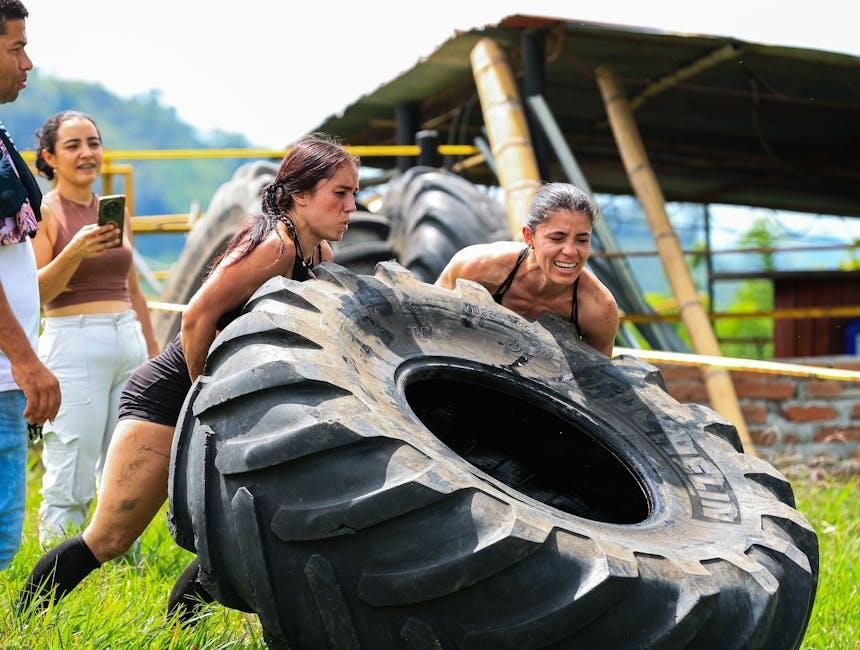
Detailed Breakdown of the Workout
The Blood and Guts Workout offers a comprehensive, high-intensity training approach, focusing on progressive overload and a structured split routine to maximize muscle growth and strength effectively.
5.1 Chest Workout
The Blood and Guts chest workout focuses on building mass and strength through high-intensity training. It typically includes exercises like the flat bench press, incline dumbbell press, and dumbbell pullovers. Yates emphasizes heavy compound movements to stimulate maximum growth. The routine often involves 4-6 sets of 6-8 reps, with a focus on progressive overload. Rest periods are kept short, around 60-90 seconds, to maintain intensity. This approach ensures a balanced chest development, targeting both the upper and lower pecs while promoting overall thoracic expansion.
5.2 Back Workout
The back workout in the Blood and Guts program focuses on building thickness and width through compound movements. Dorian Yates emphasizes deadlifts, bent-over rows, and pull-ups as foundational exercises. Typically, 4-6 sets of 6-8 reps are performed for deadlifts and rows, while pull-ups are done to failure or with added weight. Lat pulldowns and seated cable rows are included for isolation work, targeting the lats and upper back. The routine is designed to maximize intensity and promote controlled form, ensuring optimal muscle engagement and growth.
- Deadlifts: 4-6 sets of 6-8 reps
- Bent-over rows: 4-6 sets of 6-8 reps
- Pull-ups: 3-4 sets to failure
- Lat pulldowns: 3-4 sets of 8-10 reps
- Seated cable rows: 3-4 sets of 8-10 reps
Rest periods are kept short to maintain intensity and maximize the workout’s effectiveness.
5.3 Shoulder Workout
Dorian Yates’ shoulder workout focuses on building width and strength, essential for a balanced physique. The routine includes overhead presses, lateral raises, and face pulls to target all deltoid heads. Yates emphasizes heavy weights and controlled movements to maximize hypertrophy. Typically, 4-6 sets of 6-8 reps are performed for each exercise, ensuring adequate volume without overtraining. The workout also incorporates rear delt exercises to maintain shoulder balance and prevent injury. Consistency and intensity are key, as Yates believes shoulders are a cornerstone of an impressive upper body.
5.4 Arm Workout
Dorian Yates’ arm workout focuses on building both biceps and triceps with compound and isolation exercises. The routine typically includes barbell curls, hammer curls, and bench dips for triceps. Yates emphasizes heavy weights and controlled movements to maximize hypertrophy. He recommends 4 sets of 6-8 reps for compound exercises and 3-4 sets of 10-12 reps for isolation movements. Rest periods are kept short to maintain intensity. This approach ensures balanced development and enhances overall arm size and definition, aligning with the Blood and Guts philosophy of high-intensity training.
5.5 Leg Workout
The leg workout in the Blood and Guts program is a cornerstone of building lower body strength and mass. It focuses on compound movements like squats, deadlifts, and leg presses to target multiple muscle groups simultaneously. Yates emphasizes heavy weights and low reps to maximize intensity. Accessories like lunges and leg curls are included to address imbalances and ensure full development. Training legs with high volume and frequency is crucial, as they are a major muscle group. Progressive overload is key to continuous growth and strength gains in this demanding workout.
5.6 Core Workout
The core workout in the Blood and Guts program focuses on building functional strength and stability. Dorian Yates emphasizes exercises like hanging leg raises, cable crunches, and planks to target the abdominals and obliques. Typically performed every other day, the core routine includes 3-4 sets of 12-15 reps per exercise. Yates stresses the importance of controlled movements to maximize muscle engagement. A strong core not only enhances athletic performance but also improves posture and overall lifting stability. This section is designed to create a solid foundation for the rest of the workout routine.

Nutrition and Supplementation for the Blood and Guts Workout
A well-structured diet with balanced macronutrients is essential for fueling intense workouts and recovery. Supplements like protein powder and creatine enhance performance and muscle growth consistency.
6.1 Caloric Intake and Macronutrient Balance
For the Blood and Guts Workout, Dorian Yates emphasizes a calorie-surplus diet to support muscle growth, with a focus on balanced macronutrients. Protein intake should be 2.2-2.5 grams per kilogram of body weight to promote muscle repair and hypertrophy. Carbohydrates are prioritized as the primary energy source for intense workouts, while healthy fats support hormone production. Meal frequency is typically 5-6 meals daily, ensuring consistent nutrient delivery. This approach fuels training intensity and recovery, aligning with the program’s high demands for optimal results.
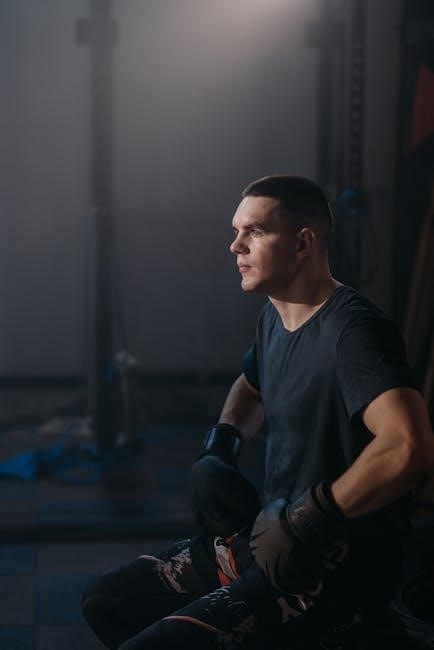
6.2 Meal Frequency and Timing
Meal frequency and timing are crucial for fueling workouts and recovery. Dorian Yates recommends 5-6 smaller meals throughout the day to maintain stable energy levels. Timing meals around workouts is key: consume a balanced meal with carbohydrates and protein 1-2 hours before training. Post-workout, a protein shake with carbohydrates within 30 minutes helps replenish glycogen and repair muscles. Staying hydrated is also vital. Consistency in meal timing supports muscle growth and recovery, aligning with the high-intensity demands of the Blood and Guts Workout.
6.3 Supplement Stack for Optimal Results
To maximize gains with the Blood and Guts Workout, Dorian Yates recommends a strategic supplement stack. Protein powder is essential for muscle repair and growth, while creatine enhances strength and endurance. BCAAs (branched-chain amino acids) help prevent muscle breakdown during intense sessions. HMB (beta-hydroxy beta-methylbutyrate) supports recovery, and L-Glutamine aids muscle health. A pre-workout stimulant can boost energy, and whey protein isolate ensures rapid absorption post-workout. Consistency with these supplements, paired with proper nutrition, accelerates results and sustains performance.
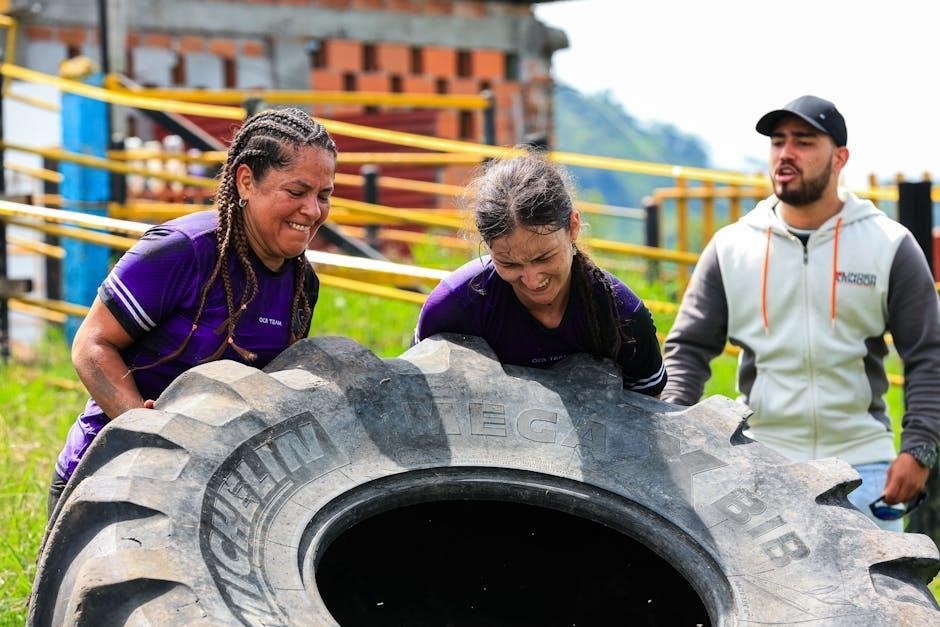
Recovery Strategies for the Blood and Guts Workout
Recovery is vital for muscle growth and injury prevention in the Blood and Guts Workout. Prioritize sleep, utilize active recovery techniques, and manage muscle soreness effectively.
7.1 Importance of Sleep
Sleep is crucial for recovery in the Blood and Guts Workout, as it enables muscle repair, growth hormone release, and mental rejuvenation. Aim for 7-9 hours nightly to support muscle growth and prevent overtraining. Poor sleep hinders recovery, reducing workout performance and muscle gains. Prioritize a consistent sleep schedule and create a restful environment to enhance sleep quality, ensuring your body recovers optimally between intense training sessions.
7.2 Active Recovery Techniques
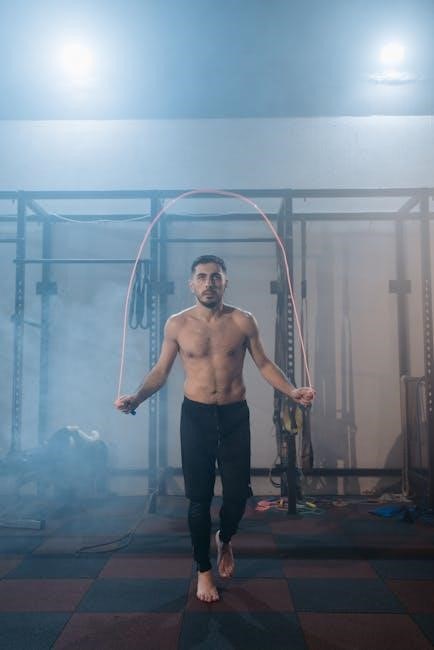
Active recovery techniques play a crucial role in the Blood and Guts Workout, enhancing muscle repair and reducing soreness. Methods like stretching, foam rolling, and light cardio improve blood flow without overtaxing muscles. Incorporating activities such as swimming or cycling at low intensity can aid in recovery while maintaining cardiovascular health. Additionally, techniques like contrast showers and self-myofascial release help reduce inflammation and promote relaxation. These practices ensure that the body remains active while recovering, supporting overall progress and longevity in the program.
7.3 Managing Muscle Soreness
Managing muscle soreness is crucial for consistent progress in the Blood and Guts Workout. Dorian Yates emphasizes the importance of stretching, foam rolling, and contrast showers to alleviate DOMS. Proper nutrition, including anti-inflammatory foods and supplements like omega-3s, aids recovery. Rest days should be utilized to allow muscles to heal, while light cardio can promote blood flow without exacerbating soreness. Yates also advocates for maintaining a consistent training schedule to build resilience over time, ensuring soreness doesn’t hinder long-term gains.
Mental Preparation and Discipline
Mental preparation and discipline are crucial for the Blood and Guts Workout, requiring unwavering focus, resilience, and consistency to push through intense training and achieve long-term success.
8.1 Building Mental Toughness
Building mental toughness is crucial for success in the Blood and Guts Workout. Dorian Yates emphasizes the importance of cultivating a resilient mindset to push through intense training sessions. Techniques like visualization, positive self-talk, and goal setting help develop this mental fortitude. By embracing challenges and staying disciplined, individuals can overcome physical and psychological barriers, ensuring consistent progress. Mental toughness not only enhances workout performance but also fosters a stronger connection between mind and body, essential for achieving long-term success in the program.
8.2 Staying Consistent
Consistency is the backbone of the Blood and Guts Workout. Dorian Yates emphasizes the importance of adhering to a structured schedule, ensuring every session is completed with dedication. By committing to the program’s principles, lifters build discipline and momentum. Tracking progress and maintaining a routine helps stay focused. Consistency also extends to nutrition and recovery, as these are integral to the workout’s success. Over time, this unwavering commitment fosters mental and physical resilience, driving long-term results.
- Create a schedule and stick to it.
- Track progress to stay motivated.
- Stay disciplined in nutrition and recovery.
8.3 Overcoming Plateaus
Plateaus are inevitable, but with the Blood and Guts Workout, Dorian Yates emphasizes strategic adjustments to break through. Periodically altering rep ranges, volume, or intensity can reignite progress. Ensuring progressive overload and maintaining consistency are crucial. Mental discipline plays a key role; staying focused and committed helps overcome stagnation. Yates advises trainees to trust the process, as plateaus often precede significant breakthroughs. By refining technique, increasing intensity, and staying patient, lifters can push past plateaus and continue achieving gains.

Common Mistakes to Avoid
Common mistakes include overtraining, insufficient recovery, and poor nutrition. Neglecting these factors can hinder progress and lead to injuries or burnout, emphasizing the importance of balance.
9.1 Overtraining
Overtraining is a common mistake that can hinder progress in the Blood and Guts Workout. It occurs when the body is pushed beyond its recovery capacity, leading to fatigue, decreased performance, and increased injury risk. Ignoring signs like persistent muscle soreness, lack of progress, and mental burnout can exacerbate the issue. To avoid overtraining, it’s crucial to balance training volume with adequate rest and recovery. Dorian Yates emphasizes the importance of listening to your body and not exceeding the program’s recommended intensity and frequency. This ensures sustainable growth without compromising long-term health.
9.2 Insufficient Recovery
Insufficient recovery is a common mistake that can hinder progress in the Blood and Guts Workout. Without adequate rest, muscles cannot repair and grow effectively, leading to overtraining and potential injury. Ignoring recovery days or skimping on sleep disrupts the body’s ability to adapt to the intense demands of HIT. This can result in chronic fatigue, decreased performance, and prolonged muscle soreness. Prioritizing recovery ensures optimal muscle growth and sustained progress, making it a cornerstone of the Blood and Guts philosophy.
9.3 Poor Nutrition
Poor nutrition is a critical mistake that can undermine the effectiveness of the Blood and Guts Workout. Neglecting proper caloric intake, macronutrient balance, and meal timing can hinder muscle growth and recovery. Many individuals fail to consume enough protein to support muscle repair, while others overconsume carbohydrates or fats, leading to suboptimal results. Additionally, neglecting supplements like creatine or protein powder can limit progress. Dorian Yates emphasizes that nutrition is the cornerstone of bodybuilding, and poor dietary habits can result in muscle loss, fatigue, and stalled progress. Consistency and discipline in nutrition are vital for success.
Success Stories and Testimonials
Many athletes credit the Blood and Guts Workout for their transformative physiques, praising its intensity and effectiveness in achieving significant muscle growth and strength gains.
10.1 Real-Life Transformations
Many individuals have experienced remarkable transformations using the Blood and Guts Workout. By adhering to its principles, people have achieved significant muscle growth, enhanced strength, and improved overall physique. The program’s focus on high-intensity training and progressive overload has empowered ordinary individuals to reach extraordinary fitness levels. These real-life success stories highlight the effectiveness of Dorian Yates’ method, proving that dedication and the right approach can lead to dramatic changes in one’s body and mindset.
10.2 Athlete Testimonials
Many professional athletes have endorsed the Blood and Guts Workout, praising its effectiveness in building strength and muscle. Elite lifters and bodybuilders often credit the program’s intensity and focus on progressive overload for their significant gains. Testimonials highlight how the workout’s emphasis on mental toughness and discipline has transformed their training mindset. Athletes appreciate the structured approach, which allows for consistent progress while minimizing plateaus. The program’s ability to deliver real results has solidified its reputation as a go-to regimen for serious athletes seeking peak physical conditioning and performance.
Dorian Yates’ Blood and Guts Workout is a proven, intense system for serious lifters seeking significant muscle growth and strength through high-intensity training and mental discipline.
11.1 Final Thoughts on the Blood and Guts Workout
The Blood and Guts Workout, developed by Dorian Yates, is a high-intensity training program designed for serious lifters. It emphasizes progressive overload and mental resilience, pushing individuals beyond their limits to foster physical and mental fortitude. This method offers a clear path to achieving remarkable muscle growth and strength for those committed to intense training and recovery. Consistency and dedication are paramount to unlocking its full potential and ensuring long-term success in bodybuilding.
11.2 Encouragement for Those Starting the Program
Embarking on the Blood and Guts Workout is a bold step toward transformation. Embrace the challenge with determination and patience, as results take time. Stay committed, trust the process, and push through discomfort. Remember, Dorian Yates’ method is not just a workout—it’s a mindset. Surround yourself with support, track your progress, and celebrate small victories. Consistency and mental toughness will be your greatest allies. Believe in your potential and the proven system. You are about to unlock a stronger, more disciplined version of yourself. The journey is worth it—start with confidence and finish with pride.
